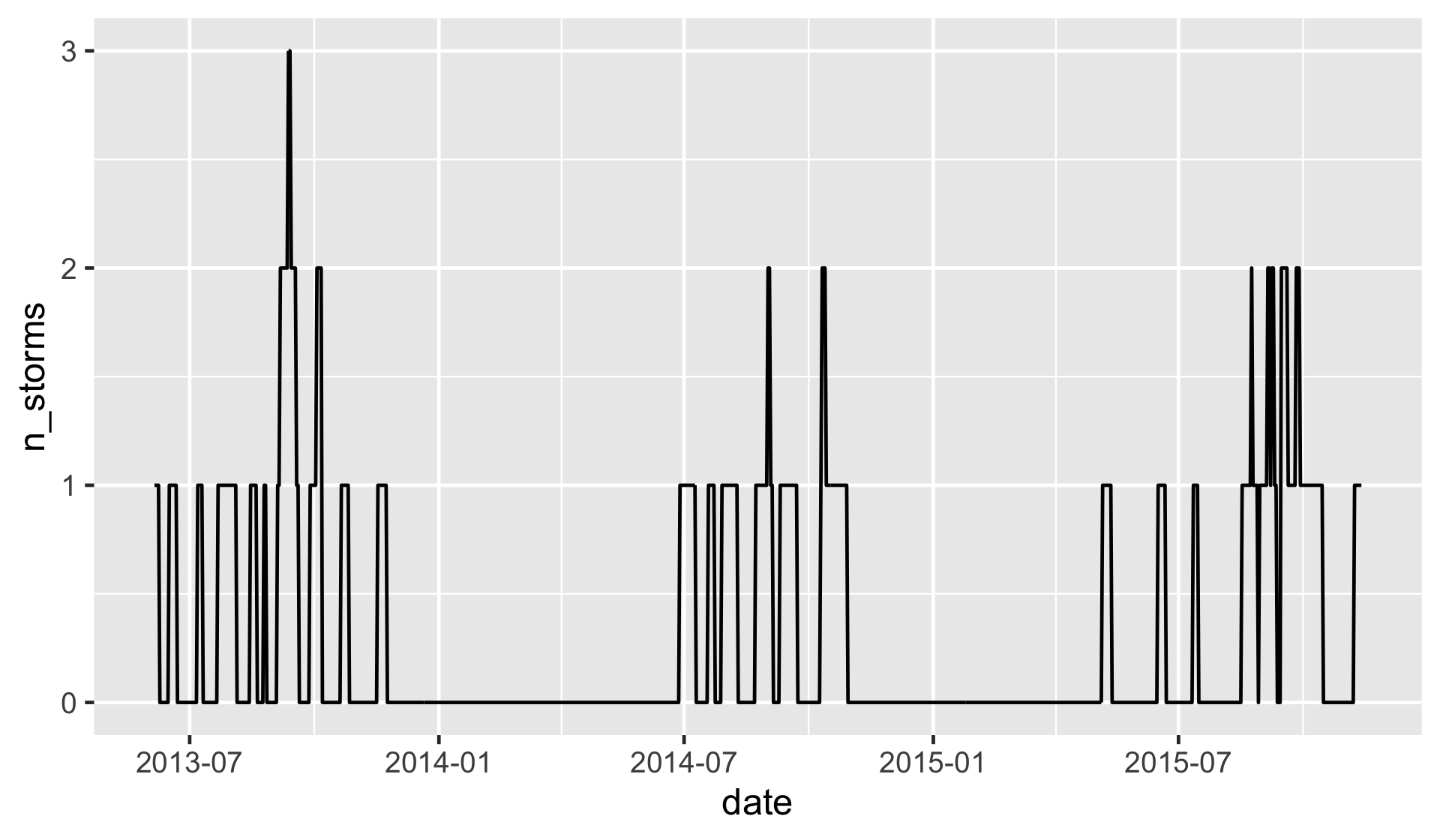Advanced completions
Reshaping Data with tidyr

Jeroen Boeye
Head of Machine Learning, Faktion
Nesting connected variables
nuke_df
# A tibble: 5 x 4
continent country n_bombs decade
<chr> <chr> <int> <int>
1 North America USA 8 1940
2 Europe USSR 1 1940
3 North America USA 188 1950
4 Europe USSR 82 1950
5 Europe UK 21 1950
Nesting connected variables
nuke_df %>%
complete(
continent,
country,
decade,
fill = list(n_bombs = 0L)
)
# A tibble: 12 x 4
continent country decade n_bombs
<chr> <chr> <int> <int>
1 Europe UK 1940 0
2 Europe UK 1950 21
3 Europe USA 1940 0
4 Europe USA 1950 0
5 Europe USSR 1940 1
6 Europe USSR 1950 82
7 North America UK 1940 0
8 North America UK 1950 0
# ... with 4 more rows
The nesting() function
nuke_df %>%
complete(
nesting(continent, country),
decade,
fill = list(n_bombs = 0L)
)
# A tibble: 6 x 4
continent country decade n_bombs
<chr> <chr> <int> <int>
1 Europe UK 1940 0
2 Europe UK 1950 21
3 Europe USSR 1940 1
4 Europe USSR 1950 82
5 North America USA 1940 8
6 North America USA 1950 188
Counting tropical storms
storm_df
# A tibble: 35 x 3
name start end
<chr> <date> <date>
1 ANDREA 2013-06-05 2013-06-08
2 ARTHUR 2014-06-28 2014-07-09
3 ANA 2015-05-06 2015-05-12
4 BARRY 2013-06-16 2013-06-21
5 TWO 2014-07-19 2014-07-23
6 BILL 2015-06-16 2015-06-21
# ... with 29 more rows
Counting tropical storms: pivot to long format
storm_df %>%
pivot_longer(
-name,
names_to = "status",
values_to = "date"
)
# A tibble: 70 x 3
name status date
<chr> <chr> <date>
1 ANDREA start 2013-06-05
2 ANDREA end 2013-06-08
3 ARTHUR start 2014-06-28
4 ARTHUR end 2014-07-09
5 ANA start 2015-05-06
6 ANA end 2015-05-12
7 BARRY start 2013-06-16
8 BARRY end 2013-06-21
9 TWO start 2014-07-19
10 TWO end 2014-07-23
# ... with 60 more rows
Counting tropical storms: grouped completion
storm_df %>%
pivot_longer(
-name,
names_to = "status",
values_to = "date"
) %>%
group_by(name) %>%
complete(date = full_seq(date, 1)) %>%
ungroup()
# A tibble: 263 x 3
name date status
<chr> <date> <chr>
1 ANA 2015-05-06 start
2 ANA 2015-05-07 NA
3 ANA 2015-05-08 NA
4 ANA 2015-05-09 NA
5 ANA 2015-05-10 NA
6 ANA 2015-05-11 NA
7 ANA 2015-05-12 end
8 ANDREA 2013-06-05 start
9 ANDREA 2013-06-06 NA
10 ANDREA 2013-06-07 NA
# ... with 253 more rows
Counting tropical storms: the actual count
storm_df %>%
pivot_longer(
-name,
names_to = "status",
values_to = "date"
) %>%
group_by(name) %>%
complete(date = full_seq(date, 1)) %>%
ungroup() %>%
count(date, name = "n_storms")
# A tibble: 227 x 2
date n_storms
<date> <int>
1 2013-06-05 1
2 2013-06-06 1
3 2013-06-07 1
4 2013-06-08 1
5 2013-06-16 1
6 2013-06-17 1
7 2013-06-18 1
8 2013-06-19 1
9 2013-06-20 1
10 2013-06-21 1
# ... with 217 more rows
Counting tropical storms: adding zero counts
storm_df %>%
pivot_longer(
-name,
names_to = "status",
values_to = "date"
) %>%
group_by(name) %>%
complete(date = full_seq(date, 1)) %>%
ungroup() %>%
count(date, name = "n_storms") %>%
complete(
date = full_seq(date, 1),
fill = list(n_storms = 0L)
)
# A tibble: 892 x 2
date n_storms
<date> <int>
1 2013-06-05 1
2 2013-06-06 1
3 2013-06-07 1
4 2013-06-08 1
5 2013-06-09 0
6 2013-06-10 0
7 2013-06-11 0
8 2013-06-12 0
9 2013-06-13 0
10 2013-06-14 0
# ... with 882 more rows
Counting tropical storms: visualizing the result

Timestamp completions
sensor_df
# A tibble: 3 x 2
time temperature
<dttm> <int>
1 2020-01-01 11:00:00 25
2 2020-01-01 11:40:00 26
3 2020-01-01 12:20:00 25
Timestamp completions
sensor_df %>%
complete(time = seq(from = min(time), to = max(time), by = "20 min"))
# A tibble: 5 x 2
time temperature
<dttm> <int>
1 2020-01-01 11:00:00 25
2 2020-01-01 11:20:00 NA
3 2020-01-01 11:40:00 26
4 2020-01-01 12:00:00 NA
5 2020-01-01 12:20:00 25
Timestamp completions
sensor_df %>%
complete(time = seq(from = min(time), to = max(time), by = "20 min")) %>%
fill(temperature)
# A tibble: 5 x 2
time temperature
<dttm> <int>
1 2020-01-01 11:00:00 25
2 2020-01-01 11:20:00 25
3 2020-01-01 11:40:00 26
4 2020-01-01 12:00:00 26
5 2020-01-01 12:20:00 25
Let's practice!
Reshaping Data with tidyr

